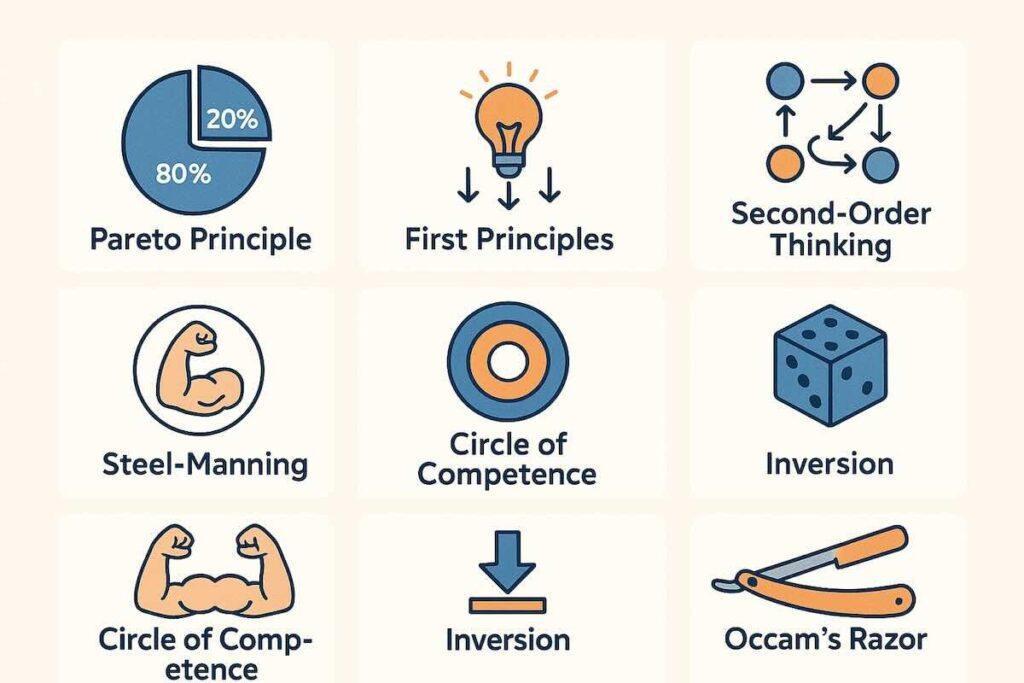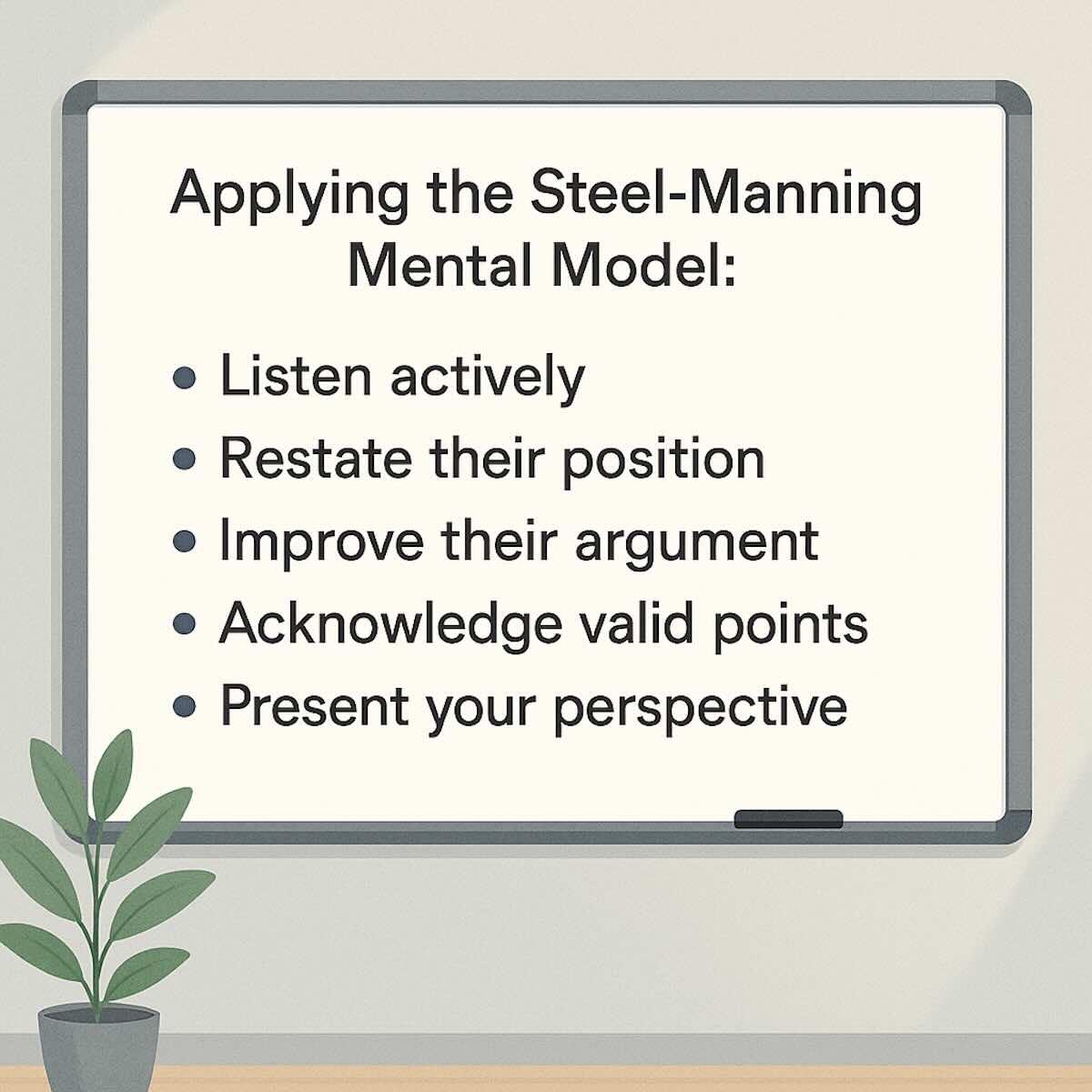Thinkers like Daniel Dennett and top companies like Apple use it to handle complex discussions well.
Understanding Mental Models
Mental models are frameworks that help us make sense of the world. They’re like cognitive shortcuts that allow us to process information more efficiently. From the Pareto Principle to Occam’s Razor, these thinking tools shape how we interpret situations and make decisions.
The steel-manning mental model belongs to a category of tools specifically designed to improve our reasoning and communication. It works by challenging our natural tendency toward confirmation bias—our inclination to favor information that supports our existing beliefs.

Mental models serve as thinking tools that help us navigate complex situations
What Is Steel-Manning?
Steel-manning is a mental model where you deliberately strengthen your opponent’s argument before responding to it. The term is a play on “straw man”—a fallacy where you misrepresent someone’s position to make it easier to attack. Steel-manning does the opposite: it creates the strongest possible version of the opposing view.
The concept originated in philosophical discourse but has gained popularity in business, politics, and personal development circles.
Philosopher Daniel Dennett describes it as part of his approach to disagreement, where you first restate the other person’s position so clearly that they say, “Thanks, I wish I’d thought of putting it that way.”
Steel-Manning vs. Straw Man: Why It Matters Today
The steel-manning mental model and the straw man mental model are at opposite ends of the debate spectrum. Straw-manning makes opposing views seem silly, while steel-manning makes them stronger. This difference can turn a conversation into a chance for insight or lead to conflict.
The Guardian reports on a 2023 Pew survey. It shows 61% of Americans find political conversations stressful and frustrating when they disagree with others.
Steel-manning aims to build trust and respect. It’s becoming more common online, where misunderstandings and echo chambers can widen divisions.
By learning to engage with opposing views more kindly, steel-manning could make our conversations better. It has the power to improve how we talk to each other.
Straw Man Argument
Misrepresents the opposing position, making it weaker and easier to defeat. Creates a “straw man” version that doesn’t accurately reflect the original argument.
Steel Man Argument
Strengthens the opposing position, representing it in its most robust and charitable form. Creates a “steel man” version that might be even stronger than the original argument.
Steel-Manning Mental Model in Action: A Real-World Example
Let’s see how steel-manning works in a business context:
Mike presented his project to Jane, the head of marketing. He had prepared for weeks for this presentation. User feedback, technical details, strategy… He had a solid plan for a new product. And he already had buy-in from his own division, engineering.
But the project would require significant investment; so he also needed Jane’s approval to proceed.
At the end of the presentation, Mike was happy with his delivery. Expecting a positive answer, he asked Jane: “What do you think?”
First, Jane gave a few compliments on Mike’s presentation and the ambitious idea. Then she said: “But what you propose is to reduce our focus on existing products, we can’t do that.”
In this scenario, Jane used a straw man argument by misrepresenting Mike’s proposal. Instead of engaging with the actual merits of the project, she created a weaker version that was easier to dismiss.
Here’s how Jane could have used steel-manning instead:
“Mike, I can see you’ve put tremendous thought into this project. The user feedback is compelling, and your technical approach seems sound. Your proposal would create a new revenue stream that could significantly grow our business in the long term. That’s the kind of innovation we need.”
“My concern is about resource allocation. Even though this project has merit, I need to understand how we’ll maintain momentum on our existing product lines while pursuing this new direction. Could we discuss how to address that challenge?”
By steel-manning Mike’s proposal, Jane acknowledges its strengths while still raising her legitimate concerns. This approach creates a collaborative atmosphere rather than an adversarial one.

Steel-manning transforms potential conflicts into collaborative problem-solving
Benefits of the Steel-Manning Mental Model
Better Understanding
When you try to build the strongest version of someone else’s argument, you gain deeper insight into their perspective. This helps you see nuances you might otherwise miss.
More Productive Debates
Steel-manning creates an atmosphere of respect and intellectual honesty. When people feel their views are being fairly represented, they’re more likely to engage constructively.
Better Decision-Making
By considering the strongest version of all arguments, you make more informed decisions. Steel-manning helps overcome confirmation bias and leads to more robust solutions.
How to Apply the Steel-Manning Mental Model

Implementing steel-manning in your thinking and communication requires practice. Here’s a step-by-step guide:
- Listen actively: Pay full attention to the other person’s argument without planning your response while they’re speaking.
- Restate their position: Summarize their argument in the strongest, most charitable form possible. Ask if your restatement is accurate.
- Improve their argument: Consider how their position could be made even stronger. What evidence or reasoning would make it more compelling?
- Acknowledge valid points: Explicitly recognize the strengths in their position before presenting your counterarguments.
- Present your perspective: Only after completing the above steps should you offer your own view or counterarguments.

The steel-manning process builds stronger arguments and better relationships
Steel-Manning Mental Model in Different Contexts
In Business
Product teams at companies like Apple use steel-manning when evaluating new ideas. By strengthening all proposals before critiquing them, they ensure the best concepts survive. This approach prevents promising innovations from being dismissed prematurely due to fixable flaws.
In Politics
Some political debates now incorporate steel-manning rules, where each participant must accurately restate their opponent’s position before responding. This practice has been shown to reduce polarization and increase the substantive quality of debates.
In Relationships
Couples therapists often teach steel-manning as a communication technique. When partners steel-man each other’s perspectives during disagreements, they demonstrate empathy and create space for mutual understanding rather than escalating conflicts.
“If you only have brains on your head you would be as good a man as any of them, and a better man than some of them. Brains are the only things worth having in this world, no matter whether one is a crow or a man.”- The Wonderful Wizard of Oz
Overcoming Challenges in Steel-Manning
When Steel-Manning Works Best
- When both parties are genuinely seeking truth
- In environments that reward intellectual honesty
- When you have time to fully consider arguments
- In complex decision-making scenarios
- When building long-term relationships
Common Pitfalls to Avoid
- Creating an unrealistic version that no one actually believes
- Using it as a delay tactic to avoid addressing the real issue
- Applying it selectively only to arguments you already favor
- Assuming the other person is using the same approach
- Forgetting to eventually present your own perspective
Effective steel-manning requires overcoming both internal and external obstacles
Conclusion: Becoming a Steel-Manning Thinker
The steel-manning mental model is more than a clever trick. It’s a powerful way to think. By strengthening opposing views, we improve our own understanding and find blind spots. This approach builds trust in our personal and professional lives.
In today’s world, where opinions are quick and loud, steel-manning is a breath of fresh air. It encourages real conversations and helps us see beyond the surface. This model is essential for making better decisions and gaining respect.
Start practicing steel-manning today. Begin with everyday talks. Acknowledge others’ ideas, even if you don’t agree. This simple shift in thinking can greatly improve your life.


